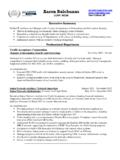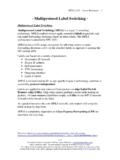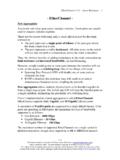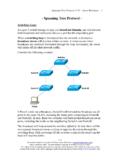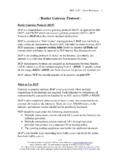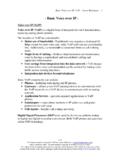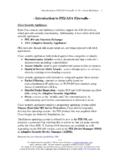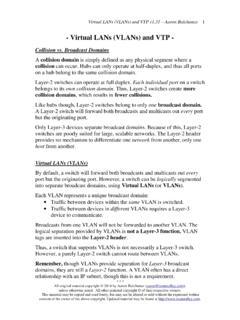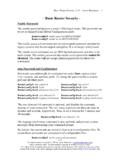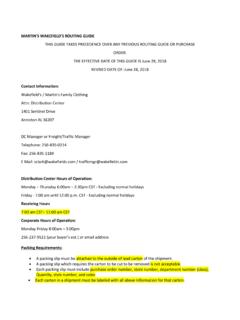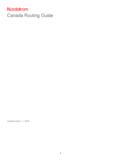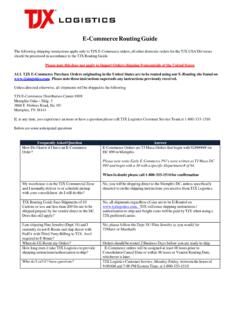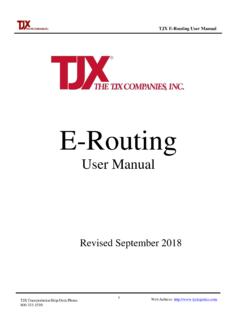Transcription of ccnp routing studyguide - Router Alley
1 ccnp routing study guide Aaron Balchunas * * * All original material copyright 2013 by Aaron Balchunas unless otherwise noted. All other material copyright of their respective owners. This material may be copied and used freely, but may not be altered or sold without the expressed written consent of the owner of the above copyright. Updated material may be found at 1 _____ Cisco ccnp routing study guide 2012 _____ Aaron Balchunas _____ Foreword: This study guide is intended to provide those pursuing the CCNP certification with a framework of what concepts need to be studied. This is not a comprehensive document containing all the secrets of the CCNP routing exam, nor is it a braindump of questions and answers. This document is freely given, and can be freely distributed. However, the contents of this document cannot be altered, without my written consent. Nor can this document be sold or published without my expressed consent.
2 I sincerely hope that this document provides some assistance and clarity in your studies. _____ ccnp routing study guide Aaron Balchunas * * * All original material copyright 2013 by Aaron Balchunas unless otherwise noted. All other material copyright of their respective owners. This material may be copied and used freely, but may not be altered or sold without the expressed written consent of the owner of the above copyright. Updated material may be found at 2 Table of Contents Part I Addressing Section 1 IPv4 Addressing Section 2 IPv6 Addressing Section 3 TCP & UDP Part II Basic routing Concepts Section 4 The routing Table Section 5 Classful vs. Classless routing Section 6 Static vs. Dynamic routing Section 7 Configuring Static Routes Section 8 Default routing Part III Dynamic routing Protocols Section 9 RIP v1 & v2 Section 10 IGRP Section 11 EIGRP Section 12 OSPF Section 13 IS-IS Section 14 BGP Part IV Advanced routing Functions Section 15 Route Redistribution Section 16 Access Control Lists Section 17 Route Filtering and Route-Maps Section 18 Multicast ccnp routing study guide Aaron Balchunas * * * All original material copyright 2013 by Aaron Balchunas unless otherwise noted.
3 All other material copyright of their respective owners. This material may be copied and used freely, but may not be altered or sold without the expressed written consent of the owner of the above copyright. Updated material may be found at 3 _____ Part I Addressing _____ ccnp routing study guide Aaron Balchunas * * * All original material copyright 2013 by Aaron Balchunas unless otherwise noted. All other material copyright of their respective owners. This material may be copied and used freely, but may not be altered or sold without the expressed written consent of the owner of the above copyright. Updated material may be found at 4 Section 1 - IPv4 Addressing and Subnetting - Hardware Addressing A hardware address is used to uniquely identify a host within a local network. Hardware addressing is a function of the Data-Link layer of the OSI model (Layer-2). Ethernet utilizes the 48-bit MAC address as its hardware address.
4 The MAC address is often hardcoded on physical network interfaces, though some interfaces support changing the MAC address using special utilities. In virtualization environments, dynamically assigning MAC addresses is very common. A MAC address is most often represented in hexadecimal, using one of two accepted formats: 00:43:AB:F2:32:13 The first six hexadecimal digits of a MAC address identify the manufacturer of the physical network interface. This is referred to as the OUI (Organizational Unique Identifier). The last six digits uniquely identify the host itself, and are referred to as the host ID. The MAC address has one shortcoming it contains no hierarchy. MAC addresses provide no mechanism to create boundaries between networks. There is no method to distinguish one network from another. This lack of hierarchy poses significant difficulties to network scalability. If only Layer-2 hardware addressing existed, all hosts would technically exist on the same network.
5 Internetworks like the Internet could not exist, as it would be impossible to separate my network from your network. Imagine if the entire Internet existed purely as a single Layer-2 switched network. Switches, as a rule, will forward a broadcast out every port. With billions of hosts on the Internet, the resulting broadcast storms would be devastating. The Internet would simply collapse. The scalability limitations of Layer-2 hardware addresses are mitigated using logical addresses, covered in great detail in this guide . ccnp routing study guide Aaron Balchunas * * * All original material copyright 2013 by Aaron Balchunas unless otherwise noted. All other material copyright of their respective owners. This material may be copied and used freely, but may not be altered or sold without the expressed written consent of the owner of the above copyright. Updated material may be found at 5 Logical Addressing Logical addressing is a function of the Network layer of the OSI Model (Layer-3), and provides a hierarchical structure to separate networks.
6 Logical addresses are never hardcoded on physical network interfaces, and can be dynamically assigned and changed freely. A logical address contains two components: Network ID identifies which network a host belongs to. Host ID uniquely identifies the host on that network. Examples of logical addressing protocols include Internetwork Packet Exchange (IPX) and Internet Protocol (IP). IPX was predominantly used on Novell networks, but is now almost entirely deprecated. IP is the most widely-used logical address, and is the backbone protocol of the Internet. Internet Protocol (IP) In the 1970 s, the Department of Defense developed the Transmission Control Protocol (TCP), to provide both Network and Transport layer functions. When this proved to be an inflexible solution, those functions were separated - with the Internet Protocol (IP) providing Network layer services, and TCP providing Transport layer services. Together, TCP and IP provide the core functionality for the TCP/IP or Internet protocol suite.
7 IP provides two fundamental Network layer services: Logical addressing provides a unique address that identifies both the host, and the network that host exists on. routing determines the best path to a particular destination network, and then routes data accordingly. IP was originally defined in RFC 760, and has been revised several times. IP Version 4 (IPv4) was the first version to experience widespread deployment, and is defined in RFC 791. IPv4 will be the focus of this guide . IPv4 employs a 32-bit address, which limits the number of possible addresses to 4,294,967,296. IPv4 will eventually be replaced by IP Version 6 (IPv6), due to a shortage of available IPv4 addresses. IPv6 is covered in great detail in another guide . ccnp routing study guide Aaron Balchunas * * * All original material copyright 2013 by Aaron Balchunas unless otherwise noted. All other material copyright of their respective owners. This material may be copied and used freely, but may not be altered or sold without the expressed written consent of the owner of the above copyright.
8 Updated material may be found at 6 IPv4 Addressing A core function of IP is to provide logical addressing for hosts. An IP address provides a hierarchical structure to both uniquely identify a host, and what network that host exists on. An IP address is most often represented in decimal, in the following format: An IP address is comprised of four octets, separated by periods: First Octet Second Octet Third Octet Fourth Octet 158 80 164 3 Each octet is an 8-bit number, resulting in a 32-bit IP address. The smallest possible value of an octet is 0, or 00000000 in binary. The largest possible value of an octet is 255, or 11111111 in binary. The above IP address represented in binary would look as follows: First Octet Second Octet Third Octet Fourth Octet 10011110 01010000 10100100 00000011 Decimal to Binary Conversion The simplest method of converting between decimal and binary is to remember the following table: 128 64 32 16 8 4 2 1 To convert a decimal number of 172 to binary, start with the leftmost column.
9 Since 172 is greater than 128, that binary bit will be set to 1. Next, add the value of the next column (128 + 64 = 192). Since 172 is less than 192, that binary bit will be set to 0. Again, add the value of the next column (128 + 32 = 160). Since 172 is greater than 160, that binary bit will be set to 1. Continue this process until the columns with binary bits set to 1 add up to 172: Decimal 128 64 32 16 8 4 2 1 Binary 1 0 1 0 1 1 0 0 ccnp routing study guide Aaron Balchunas * * * All original material copyright 2013 by Aaron Balchunas unless otherwise noted. All other material copyright of their respective owners. This material may be copied and used freely, but may not be altered or sold without the expressed written consent of the owner of the above copyright. Updated material may be found at 7 Binary to Decimal Conversion Converting from binary back to decimal is even simpler. Apply the binary number to the conversion table, and then add up any columns with binary bits set to 1.
10 For example, consider the binary number of 11110001: Decimal 128 64 32 16 8 4 2 1 Binary 1 1 1 1 0 0 0 1 By adding 128 + 64 + 32 + 16+ 1, it can be determined that 11110001 equals 241. The Subnet Mask Part of an IP address identifies the network. The other part of the address identifies the host. A subnet mask is required to provide this distinction: The above IP address has a subnet mask of The subnet mask follows two rules: If a binary bit is set to a 1 (or on) in a subnet mask, the corresponding bit in the address identifies the network. If a binary bit is set to a 0 (or off) in a subnet mask, the corresponding bit in the address identifies the host. Looking at the above address and subnet mask in binary: IP Address: Subnet Mask: The first 16 bits of the subnet mask are set to 1. Thus, the first 16 bits of the address ( ) identify the network. The last 16 bits of the subnet mask are set to 0. Thus, the last 16 bits of the address ( ) identify the unique host on that network.

